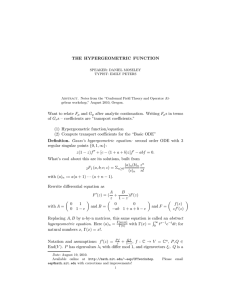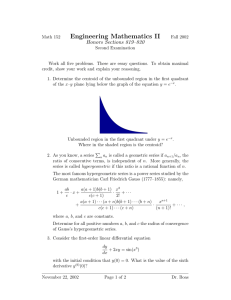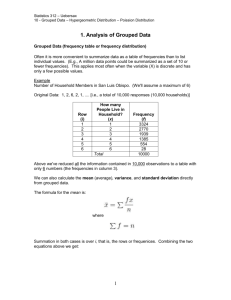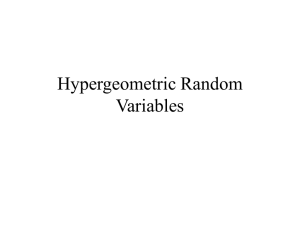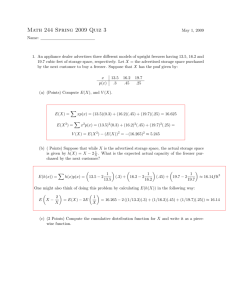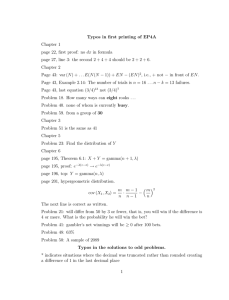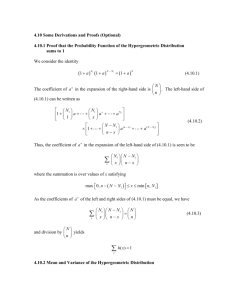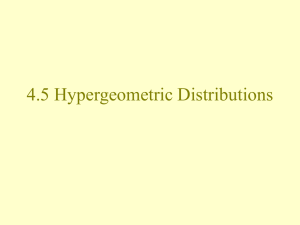Hypergeometric τ Functions of the q-Painlev´ e Systems of Type (A + A
advertisement
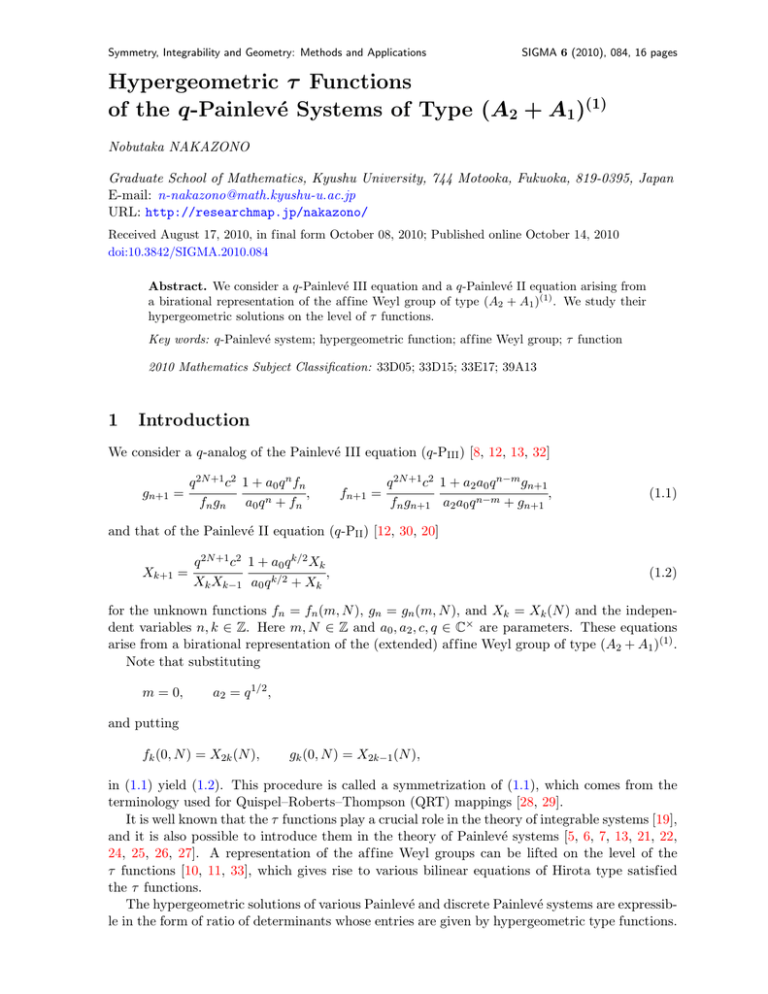
Symmetry, Integrability and Geometry: Methods and Applications SIGMA 6 (2010), 084, 16 pages Hypergeometric τ Functions of the q-Painlevé Systems of Type (A2 + A1)(1) Nobutaka NAKAZONO Graduate School of Mathematics, Kyushu University, 744 Motooka, Fukuoka, 819-0395, Japan E-mail: n-nakazono@math.kyushu-u.ac.jp URL: http://researchmap.jp/nakazono/ Received August 17, 2010, in final form October 08, 2010; Published online October 14, 2010 doi:10.3842/SIGMA.2010.084 Abstract. We consider a q-Painlevé III equation and a q-Painlevé II equation arising from a birational representation of the affine Weyl group of type (A2 + A1 )(1) . We study their hypergeometric solutions on the level of τ functions. Key words: q-Painlevé system; hypergeometric function; affine Weyl group; τ function 2010 Mathematics Subject Classification: 33D05; 33D15; 33E17; 39A13 1 Introduction We consider a q-analog of the Painlevé III equation (q-PIII ) [8, 12, 13, 32] gn+1 = q 2N +1 c2 1 + a0 q n fn , fn gn a0 q n + fn fn+1 = q 2N +1 c2 1 + a2 a0 q n−m gn+1 , fn gn+1 a2 a0 q n−m + gn+1 (1.1) and that of the Painlevé II equation (q-PII ) [12, 30, 20] Xk+1 = q 2N +1 c2 1 + a0 q k/2 Xk , Xk Xk−1 a0 q k/2 + Xk (1.2) for the unknown functions fn = fn (m, N ), gn = gn (m, N ), and Xk = Xk (N ) and the independent variables n, k ∈ Z. Here m, N ∈ Z and a0 , a2 , c, q ∈ C× are parameters. These equations arise from a birational representation of the (extended) affine Weyl group of type (A2 + A1 )(1) . Note that substituting m = 0, a2 = q 1/2 , and putting fk (0, N ) = X2k (N ), gk (0, N ) = X2k−1 (N ), in (1.1) yield (1.2). This procedure is called a symmetrization of (1.1), which comes from the terminology used for Quispel–Roberts–Thompson (QRT) mappings [28, 29]. It is well known that the τ functions play a crucial role in the theory of integrable systems [19], and it is also possible to introduce them in the theory of Painlevé systems [5, 6, 7, 13, 21, 22, 24, 25, 26, 27]. A representation of the affine Weyl groups can be lifted on the level of the τ functions [10, 11, 33], which gives rise to various bilinear equations of Hirota type satisfied the τ functions. The hypergeometric solutions of various Painlevé and discrete Painlevé systems are expressible in the form of ratio of determinants whose entries are given by hypergeometric type functions. 2 N. Nakazono Usually, they are derived by reducing the bilinear equations to the Plücker relations by using the contiguity relations satisfied by the entries of determinants [2, 3, 4, 8, 9, 13, 14, 15, 16, 20, 23, 31]. This method is elementary, but it encounters technical difficulties for Painlevé systems with large symmetries. In order to overcome this difficulty, Masuda has proposed a method of constructing hypergeometric solutions under a certain boundary condition on the lattice where the τ functions live (hypergeometric τ functions), so that they are consistent with the action of the affine Weyl groups. Although this requires somewhat complex calculations, the merit is that it is systematic and that it can be applied to the systems with large symmetries. Masuda has carried out the (1) (1) calculations for the q-Painlevé systems with E7 and E8 symmetries [17, 18] and presented explicit determinant formulae for their hypergeometric solutions. The purpose of this paper is to apply the above method to the q-Painlevé systems with the affine Weyl group symmetry of type (A2 + A1 )(1) and present the explicit formulae of the hypergeometric τ functions. The hypergeometric τ functions provide not only determinant formulae but also important information originating from the geometry of lattice of the τ functions. The result has been already announced in [12] and played an essential role in clarifying the mechanism of reduction from hypergeometric solutions of (1.1) to those of (1.2). This paper is organized as follows: in Section 2, we first review hypergeometric solutions of q-PIII and then those of q-PII . We next introduce a representation of the affine Weyl group of type (A2 + A1 )(1) . In Section 3, we construct the hypergeometric τ functions of q-PIII and those of q-PII . We find that the symmetry of the hypergeometric τ functions of q-PIII are connected with Heine’s transform of the basic hypergeometric series 2 ϕ1 . We use the following conventions of q-analysis throughout this paper [1]. q-Shifted factorials: (a; q)k = k Y 1 − aq i−1 . i=1 Basic hypergeometric series: X ∞ 1+r−s n (a1 , . . . , as ; q)n a1 , . . . , as ; q, z = z , (−1)n q n(n−1)/2 s ϕr b1 , . . . , b r (b1 , . . . , br ; q)n (q; q)n n=0 where (a1 , . . . , as ; q)n = s Y (ai ; q)n . i=1 Jacobi theta function: Θ(a; q) = (a; q)∞ qa−1 ; q ∞ . Elliptic gamma function: Γ(a; p, q) = (pqa−1 ; p, q)∞ , (a; p, q)∞ where (a; p, q)k = k−1 Y 1 − pi q j a . i,j=0 It holds that Θ(qa; q) = −a−1 Θ(a; q), Γ(qa; q, q) = Θ(a; q)Γ(a; q, q). Hypergeometric τ Functions of the q-Painlevé Systems of Type (A2 + A1 )(1) 2 3 q-PIII and q-PII 2.1 Hypergeometric solutions of q-PIII and q-PII First, we review the hypergeometric solutions of q-PIII and q-PII . The hypergeometric solutions of q-PIII have been constructed as follows: Proposition 2.1 ([8]). The hypergeometric solutions of q-PIII , (1.1), with c = 1 are given by fn = −a0 q n n,m−1 n,m ψN +1 ψN n,m n,m−1 ψN +1 ψN , gn = a0 n,m where ψN (N ∈ Z≥0 ) is an N × N Fn,m Fn+1,m Fn−1,m Fn,m n,m ψN = .. .. . . Fn−N +1,m Fn−N +2,m −1 a2 q −n−m+1 n,m n−1,m−1 ψN +1 ψN n−1,m−1 n,m ψN ψN +1 , determinant defined by · · · Fn+N −1,m · · · Fn+N −2,m ψ0n,m = 1, , .. .. . . ··· Fn,m and Fn,m is an arbitrary solution of the systems Fn+1,m − Fn,m = −a0 2 q 2n Fn,m−1 , Fn,m+1 − Fn,m = −a2 −2 2m+2 q Fn−1,m . (2.1) (2.2) The general solution of (2.1) and (2.2) is given by Fn,m An,m 0 2 2 2 2n−2m = ; q , a2 a0 q 1 ϕ1 a2 2 q −2m (a2 −2 q 2m+2 ; q 2 )∞ Θ(a0 2 a2 2 q 2n−2m−2 ; q 2 ) 0 2 2 2n+2 + Bn,m ; q , a0 q , 1 ϕ1 a2 −2 q 2m+4 (a2 2 q −2m−2 ; q 2 )∞ Θ(a0 2 q 2n ; q 2 ) (2.3) where An,m and Bn,m are periodic functions of period one with respect to n and m, i.e., An,m = An+1,m = An,m+1 , Bn,m = Bn+1,m = Bn,m+1 . The explicit form of the hypergeometric solutions of q-PII are given as follows: Proposition 2.2 ([20]). The hypergeometric solutions of q-PII , (1.2), with c = 1 are given by Xk = −a0 q k/2+N φkN +1 φk−1 N k φk−1 N +1 φN , where φkN (N ∈ Z≥0 ) is an N × N determinant defined by Gk Gk−1 · · · Gk−N +1 Gk+2 Gk+1 · · · Gk−N +3 φk0 = 1, φkN = , .. .. .. .. . . . . Gk+2N −2 Gk+2N −3 · · · Gk+N −1 (2.4) (2.5) and Gk is an arbitrary solution of the system Gk+1 − Gk + a0 −2 q −k Gk−1 = 0. (2.6) 4 N. Nakazono The general solution of (2.6) is given by 0 (2k+1)/4 1/2 1/2 (3+2k)/4 Gk = Ak Θ(ia0 q ; q ) 1 ϕ1 ; q , −ia0 q −q 1/2 0 (2k+1)/4 1/2 1/2 (3+2k)/4 , + Bk Θ(−ia0 q ; q ) 1 ϕ1 ; q , ia0 q −q 1/2 (2.7) where Ak and Bk are periodic functions of period one, i.e., Ak = Ak+1 , 2.2 Bk = Bk+1 . Projective reduction from q-PIII and q-PII We formulate the family of Bäcklund transformations of q-PIII and q-PIV as a birational representation of the affine Weyl group of type (A2 + A1 )(1) . Here, q-PIV is a q-analog of the Painlevé IV equation discussed in [13]. We refer to [21] for basic ideas of this formulation. We define the transformations si (i = 0, 1, 2) and π on the variables fj (j = 0, 1, 2) and parameters ak (k = 0, 1, 2) by !uij a + f i i si (aj ) = aj ai −aij , si (fj ) = fj , 1 + ai fi π(ai ) = ai+1 , π(fi ) = fi+1 , for i, j ∈ Z/3Z. Here the symmetric 3 × 3 matrix 2 −1 −1 A = (aij )2i,j=0 = −1 2 −1 , −1 −1 2 (1) is the Cartan matrix of type A2 , and the skew-symmetric one 0 1 −1 1 , U = (uij )2i,j=0 = −1 0 1 −1 0 represents an orientation of the corresponding Dynkin diagram. We also define the transformations wj (j = 0, 1) and r by ai ai+1 (ai−1 ai + ai−1 fi + fi−1 fi ) , fi−1 (ai ai+1 + ai fi+1 + fi fi+1 ) 1 + ai fi + ai ai+1 fi fi+1 w1 (fi ) = , ai ai+1 fi+1 (1 + ai−1 fi−1 + ai−1 ai fi−1 fi ) 1 r(fi ) = , fi w0 (fi ) = w0 (ai ) = ai , w1 (ai ) = ai , r(ai ) = ai , for i ∈ Z/3Z. Proposition 2.3 ([13]). The group of birational transformations hs0 , s1 , s2 , π, w0 , w1 , ri forms f ((A2 + A1 )(1) ). Namely, the transforthe affine Weyl group of type (A2 + A1 )(1) , denoted by W mations satisfy the fundamental relations si 2 = (si si+1 )3 = π 3 = 1, w0 2 = w1 2 = r2 = 1, πsi = si+1 π (i ∈ Z/3Z), rw0 = w1 r, f (A(1) ) = hs0 , s1 , s2 , πi and that of W f (A(1) ) = hw0 , w1 , ri commute with each and the action of W 2 1 other. Hypergeometric τ Functions of the q-Painlevé Systems of Type (A2 + A1 )(1) 5 f ((A2 + A1 )(1) ) act as In general, for a function F = F (ai , fj ), we let an element w ∈ W w.F (ai , fj ) = F (ai .w, fj .w), that is, w acts on the arguments from the right. Note that a0 a1 a2 = f ((A2 + A1 )(1) ) and W f (A(1) ), respectively. q and f0 f1 f2 = qc2 are invariant under the action of W 2 We define the translations Ti (i = 1, 2, 3, 4) by T1 = πs2 s1 , T2 = s1 πs2 , T3 = s2 s1 π, T4 = rw0 , (2.8) whose action on parameters ai (i = 0, 1, 2) and c is given by T1 : (a0 , a1 , a2 , c) 7→ qa0 , q −1 a1 , a2 , c , T2 : (a0 , a1 , a2 , c) 7→ (a0 , qa1 , q −1 a2 , c), T3 : (a0 , a1 , a2 , c) 7→ q −1 a0 , a1 , qa2 , c , T4 : (a0 , a1 , a2 , c) 7→ (a0 , a1 , a2 , qc). Note that Ti (i = 1, 2, 3, 4) commute with each other and T1 T2 T3 = 1. The action of T1 on the f -variables can be expressed as T1 (f1 ) = qc2 1 + a0 f0 , f1 f0 a0 + f0 T1 (f0 ) = qc2 1 + a2 a0 T1 (f1 ) . f0 T1 (f1 ) a2 a0 + T1 (f1 ) (2.9) Or, applying T1 n T2 m T4 N (n, m, N ∈ Z) on (2.9) and putting n,m fi,N = T1 n T2 m T4 N (fi ) (i = 0, 1, 2), we obtain n+1,m f1,N n,m q 2N +1 c2 1 + a0 q n f0,N = n,m n,m n,m , f1,N f0,N a0 q n + f0,N n+1,m f0,N = q 2N +1 c2 n+1,m 1 + a2 a0 q n−m f1,N n,m n+1,m n+1,m f1,N f0,N a2 a0 q n−m + f1,N , which is equivalent to q-PIII . Then T1 and Ti (i = 2, 4) are regarded as the time evolution and Bäcklund transformations of q-PIII , respectively. We here note that we also obtain q-PIV by identifying T4 as a time evolution [13]. In order to formulate the symmetrization to q-PII , it is crucial to introduce the transformation R1 defined by R1 = π 2 s1 , (2.10) which satisfies R1 2 = T 1 . Considering the projection of the action of R1 on the line a2 = q 1/2 , we have R1 : (a0 , a1 , c) 7→ (q 1/2 a0 , q −1/2 a1 , c), R1 (f0 ) = qc2 1 + a0 f0 , f0 f1 a0 + f0 R1 (f1 ) = f0 . Applying R1 k T4 N on (2.11) and putting k fi,N = R1 k T4 N (fi ) (i = 0, 1, 2), we have k+1 f0,N = k q 2N +1 c2 1 + a0 q k/2 f0,N k f k−1 a q k/2 + f k f0,N 0 0,N 0,N , (2.11) 6 N. Nakazono which is equivalent to q-PII . Then R1 and T4 are regarded as the time evolution and a Bäcklund transformation of q-PII , respectively. In general, we can derive various discrete Painlevé systems from elements of infinite order of affine Weyl groups that are not necessarily translations by taking a projection on a certain subspace of the parameter space. We call such a procedure a projective reduction [12]. The symmetrization is a kind of the projective reduction. 2.3 f ((A2 + A1 )(1) ) on the τ function Birational representation of W We introduce the new variables τi and τ i (i ∈ Z/3Z) by letting fi = q 1/3 c2/3 τ i+1 τi−1 , τi+1 τ i−1 and lift a representation to the affine Weyl group on their level: Proposition 2.4 ([33]). We define the action of si (i = 0, 1, 2), π, wj (j = 0, 1), and r on τk and τ k (k = 0, 1, 2) by the following formulae: ui τi+1 τ i−1 + τ i+1 τi−1 , ui 1/2 τ i vi τ i+1 τi−1 + τi+1 τ i−1 si (τ i ) = , vi 1/2 τi π(τi ) = τi+1 , si (τj ) = τj (i 6= j), si (τi ) = w0 (τ i ) = si (τ j ) = τ j (i 6= j), π(τ i ) = τ i+1 , ai+1 1/3 (τ i τi+1 τi+2 + ui−1 τi τ i+1 τi+2 + ui+1 −1 τi τi+1 τ i+2 ) , ai+2 1/3 τ i+1 τ i+2 ai+1 1/3 (τi τ i+1 τ i+2 + vi−1 τ i τi+1 τ i+2 + vi+1 −1 τ i τ i+1 τi+2 ) , ai+2 1/3 τi+1 τi+2 r(τi ) = τ i , w1 (τi ) = w0 (τi ) = τi , w1 (τ i ) = τ i , r(τ i ) = τi , with ui = q −1/3 c−2/3 ai , vi = q 1/3 c2/3 ai , f ((A2 + A1 )(1) ). where i, j ∈ Z/3Z. Then, hs0 , s1 , s2 , π, w0 , w1 , ri forms the affine Weyl group W n,m We define the τ function τN (n, m, N ∈ Z) by n,m τN = T1 n T2 m T4 N (τ1 ). We note that τ0 = τ0−1,0 , τ1 = τ00,0 , τ 0 = τ1−1,0 , τ2 = τ00,1 , τ 1 = τ10,0 , τ 2 = τ10,1 , (2.12) and n,m f0,N n,m f2,N =q (2N +1)/3 2/3 =q (2N +1)/3 2/3 c c n,m n,m+1 τN +1 τN n,m n,m+1 τN τN +1 n−1,m n,m τN +1 τN n−1,m n,m τN τN +1 , . n,m f1,N =q (2N +1)/3 2/3 c n,m+1 n−1,m τN +1 τN n,m+1 n−1,m τN τN +1 , Hypergeometric τ Functions of the q-Painlevé Systems of Type (A2 + A1 )(1) 7 Let us consider the τ functions for q-PII . We set k τN = R1 k T4 N (τ1 ). Note that τ0 = τ0−2 , τ1 = τ00 , τ2 = τ0−1 , τ 0 = τ1−2 , τ 1 = τ10 , τ 2 = τ1−1 , (2.13) and k f0,N = q (2N +1)/3 c2/3 k−1 k τN +1 τN k τ k−1 τN N +1 . In general, it follows that n,0 2n τN = τN , n,1 2n−1 τN = τN . For convenience, we introduce αi , γ, and Q by αi 6 = ai , 3 γ 6 = c, Q6 = q. Hypergeometric τ functions of the q-Painlevé systems of type (A2 + A1 )(1) In this section, we construct the hypergeometric τ functions of q-PIII and q-PII . We define the n,m consistent with the action of hT1 , T2 , T3 , T4 i. We hypergeometric τ functions of q-PIII by τN k consistent with the action of hR , T i. also define the hypergeometric τ functions of q-PII by τN 1 4 Here, we mean τ (α) consistent with a action of transformation r as r.τ (α) = τ (α.r). n,m We then regard τN as function in α0 and α2 , i.e., 0,0 n,m (Qn α0 , Q−m α2 ). = τN τN k as function in α , i.e., We also regard τN 0 k 0 τN = τN (Qk/2 α0 ). 3.1 Hypergeometric τ functions of q-PIII We construct the hypergeometric τ functions of q-PIII . By the action of the affine Weyl group, n,m τN is determined as a rational function in τ0n,m and τ1n,m (or τi and τ i ). Thus, our purpose is n,m determining τ0n,m and τ1n,m consistent with the action of hT1 , T2 , T3 , T4 i and constructing τN under the condition γ = 1, (3.1) and the boundary condition n,m τN =0 (N < 0). (3.2) First we consider the condition for τ0n,m which follows from the boundary condition (3.2). We use the bilinear equations obtained in [12]: 8 N. Nakazono Proposition 3.1. The following bilinear equations hold: n,m n,m n,m 2 n,m+1 n,m−1 4n−8m+4 τN α1 −4 α2 4 τN − Qn−2m+1 α1 −1 α2 τN τN = 0, +1 τN −1 + Q n,m n,m n,m 2 4n+4m 4 −4 n+m −1 n+1,m+1 n−1,m−1 τN +1 τN −1 + Q α0 α2 τN −Q α0 α2 τN τN = 0, n,m n,m n,m 2 n+1,m n−1,m −8n+4m−4 −4 4 −2n+m−1 −1 τN +1 τN −1 + Q α0 α1 τN −Q α0 α1 τN τN = 0. (3.3) (3.4) (3.5) By putting N = 0 in (3.3)–(3.5), we get 2 Q4n−8m+4 α1 −4 α2 4 (τ0n,m ) − Qn−2m+1 α1 −1 α2 τ0n,m+1 τ0n,m−1 = 0, 2 (3.6) Q4n+4m α0 4 α2 −4 (τ0n,m ) − Qn+m α0 α2 −1 τ0n+1,m+1 τ0n−1,m−1 = 0, (3.7) 2 Q−8n+4m−4 α0 −4 α1 4 (τ0n,m ) (3.8) − Q−2n+m−1 α0 −1 α1 τ0n+1,m τ0n−1,m = 0. We set τ0n,m = Γ(Q2n−m+1 α0 2 α2 ; Q, Q)Γ(Q−n+2m−1 α1 2 α0 ; Q, Q)Γ(Q−n−m α2 2 α1 ; Q, Q)An,m 0 . (3.9) From (3.6)–(3.8), the following equations hold: n,m+1 n,m−1 2 A0 , (An,m 0 ) = A0 (3.10) n+1,m+1 n−1,m−1 2 (An,m A0 , 0 ) = A0 (3.11) . An−1,m = An+1,m 0 0 n,m and determine τ0 2 (An,m 0 ) We next of T1 , T2 , and T3 are given by (3.12) τ1n,m . From (2.8) and Proposition 2.4, we see that the action Ti (τi−1 ) = τi , (3.13) Ti (τ i−1 ) = τ i , (3.14) αi−1 6τ + i τi+1 , Qαi−1 3 τ i−1 Q2 αi−1 6 τi+1 τ i + τ i+1 τi , Ti (τ i+1 ) = Qαi−1 3 τi−1 2 1 τi 2 αi+1 αi−1 4 τi τ i αi 2 αi−1 2 τ i τi τi+1 3 τ i τi+1 Ti (τi ) = + + + α , i+1 αi+1 3 αi−1 6 τi−1 αi 2 τ i−1 αi+1 τ i+1 τi−1 τ i+1 τ i−1 1 τ i2 τi τ i + αi 2 αi+1 5 αi−1 8 Ti (τ i ) = 3 6 αi+1 αi−1 τ i−1 τi−1 2 τi τ i τ i+1 1 3 τi τ i+1 + 2 + α , i+1 αi αi+1 5 αi−1 2 τi+1 τ i−1 τi+1 τi−1 Ti (τi+1 ) = i τ i+1 Q2 τ (3.15) (3.16) (3.17) (3.18) where i = 1, 2, 3. Lemma 3.1. If τi and τ i are consistent with (3.13)–(3.16), then they are also consistent with (3.17) and (3.18). Proof . Applying Ti−1 on (3.16) and using (3.13) and (3.14), we have Ti (τi ) = τi αi+1 2 αi−1 2 τ i Q T (τ ) + Ti (τi+1 ). i i+1 αi+1 3 αi−1 3 τ i+1 αi τ i+1 (3.19) By using (3.15) and (3.16) for (3.19), we get (3.17). Similarly, applying Ti−1 on (3.15) and using (3.13) and (3.14), we have Ti (τ i ) = 1 τi Qαi+1 3 αi−1 3 τi+1 Ti (τi+1 ) + Qαi−1 3 αi+1 3 By using (3.15) and (3.16) for (3.20), we get (3.18). τi τi+1 Ti (τ i+1 ). (3.20) Hypergeometric τ Functions of the q-Painlevé Systems of Type (A2 + A1 )(1) 9 From (2.12), we rewrite (3.15) and (3.16) as follows: τ0−1,0 τ10,1 − Q−1 α1 3 τ0−1,1 τ10,0 + Q−2 α1 6 τ00,1 τ1−1,0 = 0, (3.21) τ00,0 τ1−1,0 − Q−1 α2 3 τ0−1,−1 τ10,1 + Q−2 α2 6 τ0−1,0 τ10,0 = τ00,1 τ10,0 − Q−1 α0 3 τ01,1 τ1−1,0 + Q−2 α0 6 τ00,0 τ10,1 = 0, τ00,1 τ1−1,0 − Qα1 3 τ00,0 τ1−1,1 + Q2 α1 6 τ0−1,0 τ10,1 = 0, τ0−1,0 τ10,0 − Qα2 3 τ00,1 τ1−1,−1 + Q2 α2 6 τ00,0 τ1−1,0 = 0, τ00,0 τ10,1 − Qα0 3 τ0−1,0 τ11,1 + Q2 α0 6 τ00,1 τ10,0 = 0. (3.22) 0, (3.23) (3.24) (3.25) (3.26) We set τ1n,m = −Q2n+2m α0 2 α2 −2 Θ(−Q−6n α0 −6 ; Q6 )Θ(−Q6m α2 −6 ; Q6 ) n,m τ0 Fn,m−1 . Θ(Q−6(n−m) α0 −6 α2 −6 ; Q6 ) (3.27) Here, Fn,m is equivalent to (2.3) because we obtain (2.1) and (2.2) from (3.24)–(3.26) and is an arbitrary constant, it does not contradict (3.21)–(3.23), respectively. If we assume An,m 0 n,m (3.10)–(3.18). Therefore, we may set A0 = 1. n,m . Finally we construct τN Theorem 3.1. Under the assumption (3.1) and (3.2), the hypergeometric τ functions of q-PIII are given as the follows: n,m = (−1)N (N +1)/2 Q−2(2n−m)N τN × 2 +6nN α0 −4N 2 +6N α2 −2N !N Θ(−Q−6n α0 −6 ; Q6 )Θ(−Q6m α2 −6 ; Q6 ) Θ(Q−6(n−m) α0 −6 α2 −6 ; Q6 ) 2 × Γ(Q2n−m+1 α0 2 α2 ; Q, Q)Γ(Q−n+2m−1 α1 2 α0 ; Q, Q) n,m−1 × Γ(Q−n−m α2 2 α1 ; Q, Q)ψN , (3.28) where n,m ψN Fn,m Fn+1,m ··· Fn−1,m Fn,m ··· = .. .. .. . . . Fn−N +1,m Fn−N +2,m · · · Fn+N −1,m Fn+N −2,m , .. . Fn,m ψ0n,m = 1, n,m ψ−N =0 (N > 0), and Fn,m An,m 0 2 2 2 2n−2m ; q , a2 a0 q = 1 ϕ1 a2 2 q −2m (a2 −2 q 2m+2 ; q 2 )∞ Θ(a0 2 a2 2 q 2n−2m−2 ; q 2 ) 0 2 2 2n+2 + Bn,m ϕ ; q , a q . 1 1 0 a2 −2 q 2m+4 (a2 2 q −2m−2 ; q 2 )∞ Θ(a0 2 q 2n ; q 2 ) Here, An,m and Bn,m are periodic functions of period one with respect to n and m. Proof . We set n,m τN = (−1)N (N +1)/2 Q−2(2n−m)N × 2 +6nN α0 −4N 2 +6N α2 −2N !N Θ(−Q−6n α0 −6 ; Q6 )Θ(−Q6m α2 −6 ; Q6 ) Θ(Q−6(n−m) α0 −6 α2 −6 ; Q6 ) 2 (3.29) 10 N. Nakazono n,m−1 × Γ(Q2n−m+1 α0 2 α2 ; Q, Q)Γ(Q−n+2m−1 α1 2 α0 ; Q, Q)Γ(Q−n−m α2 2 α1 ; Q, Q)ψN . From (3.2), (3.9), and (3.27), we find n,m ψN =0 (N < 0), ψ0n,m = 1, ψ1n,m = Fn,m . n,m Furthermore, it is easily verified that ψN satisfy n,m n,m n,m ψN +1 ψN −1 − ψN 2 n+1,m n−1,m + ψN ψN = 0, (3.30) from (3.5). In general, (3.30) admits a solution expressed in terms of the Toeplitz type determinant n,m ψN = det (cn−i+j,m )i,j=1,...,N (N > 0), under the boundary conditions n,m ψN =0 (N < 0), ψ0n,m = 1, ψ1n,m = cn,m , where cn,m is an arbitrary function. Therefore we have completed the proof. 3.2 Hypergeometric τ functions of q-PII In this section, we construct the hypergeometric τ functions of q-PII by two methods. 3.2.1 Hypergeometric τ functions of q-PII (I) We construct the hypergeometric τ functions of q-PII by using those of q-PIII . We here note n,m consistent with the action of hs2 , T1 , T2 , T3 , T4 i is also consistent with the action of R1 that τN because R1 = s2 T2 −1 . n,m consistent with the action of hs2 , T1 , T2 , T3 , T4 i. The action of s2 Therefore, we construct τN n,m on τN is n−m,−m n,m . ) = τN s2 (τN (3.31) n,m is determined as a rational function in τ0n,m We consider only τ0n,m and τ1n,m because τN and τ1n,m . It easily verified that τ0n,m , (3.28) (or (3.9)), is consistent with the action of s2 . When N = 1, we rewrite (3.31) as s2 (Fn,m−1 ) = α2 −12 Q−12m Θ(α0 −12 Q12m−12n ; Q12 ) Fn−m,−m−1 , Θ(α0 −12 α2 −12 Q−12n ; Q12 ) (3.32) from (3.28). Moreover, by using (3.29), (3.32) can be rewritten as s2 (An,m ) − Bn,m 0 12 12 12n−12m+12 ϕ ; Q , α Q 1 1 0 α2 −12 Q−12m+12 (α2 12 Q12m ; Q12 )∞ (An,m − s2 (Bn,m ))Θ(α0 12 Q12n−12m ; Q12 ) 0 12 12 12 12n+12 = ; Q , α0 α2 Q , 1 ϕ1 α2 12 Q12m+12 (α2 −12 Q−12m ; Q12 )∞ Θ(α0 12 α2 12 Q12n ; Q12 ) which implies that τ1n,m is also consistent with the action of s2 when s2 (An,m ) = Bn,m . (3.33) Hypergeometric τ Functions of the q-Painlevé Systems of Type (A2 + A1 )(1) 11 Lemma 3.2. Under the assumption (3.33), the hypergeometric τ functions (3.28) are consistent with the action of hs2 , T1 , T2 , T3 , T4 i. Therefore we easily obtain the following theorem: Theorem 3.2. Setting R1 (An,m ) = Bn,m , (3.34) α2 = Q1/2 , and putting n,0 2n τN = τN , n,1 2n−1 τN = τN , n,m we obtain the hypergeometric τ functions of q-PII . Here τN is given by (3.28). In general, the entries of determinants of the hypergeometric τ functions of Painlevé systems are expressed by two-parameter family of the functions satisfying the contiguity relations. However the hypergeometric τ functions of q-PII in Theorem 3.2 have only one parameter because of the condition (3.34). In the next section, we construct the hypergeometric τ functions of q-PII which admits two parameters. 3.2.2 Hypergeometric τ functions of q-PII (II) We construct the hypergeometric τ functions of q-PII whose ratios correspond to the hyperk is geometric solutions of q-PII in Proposition 2.2. By the action of the affine Weyl group, τN k k determined as a rational function of τ0 and τ1 (or τi and τ i ). Thus, our purpose is determining τ0k k under the conditions and τ1k consistent with the action of hR1 , T4 i and constructing τN α2 = Q1/2 , γ = 1, (3.35) and the boundary condition k τN =0 (N < 0). (3.36) First we consider the condition for τ0k which follows from the boundary condition (3.36). We use the bilinear equation obtained in [12]: Proposition 3.2. The following bilinear equation holds: k+2 k−1 k+1 k k+1 k (k−4N +1)/2 −2 τN γ α0 τN τN − Q−k+4N −1 γ 4 α0 −2 τN τN = 0. +1 τN −1 − Q (3.37) By putting N = 0 in (3.37), we get Q3(k+1)/2 α0 3 τ0k+2 τ0k−1 + τ0k+1 τ0k = 0. (3.38) We set τ0k = Γ Q(2k+3)/2 α0 2 ; Q, Q Γ Q−k/2 α0 −1 ; Q, Q Γ Q(−k+3)/2 α0 −1 ; Q, Q Ak1 . (3.39) From (3.38), Ak1 satisfies k−1 k Ak+2 = Ak+1 1 A1 1 A1 . (3.40) 12 N. Nakazono We next determine τ0k and τ1k . From (2.10) and Proposition 2.4, we see that the action of R1 on τ0k and τ1k is given by R1 (τ0 ) = τ2 , R1 (τ1 ) = (3.41) Q−2 α0 6 τ1 τ 2 + τ 1 τ2 , Q−1 α0 3 τ 0 (3.42) R1 (τ2 ) = τ1 , (3.43) R1 (τ 0 ) = τ 2 , (3.44) R1 (τ 1 ) = Q2 α0 6 τ 1 τ2 + τ1 τ 2 , Qα0 3 τ0 (3.45) R1 (τ 2 ) = τ 1 . (3.46) From (2.13), we rewrite (3.42) and (3.45) as Qα0 −3 τ1−2 τ01 − Q2 α0 −6 τ10 τ0−1 − τ00 τ1−1 = 0, (3.47) Q−1 α0 −3 τ0−2 τ11 − Q−2 α0 −6 τ00 τ1−1 − τ10 τ0−1 = 0, (3.48) respectively. Setting τ1k = τ0k Gk , Θ(Q3k+1 α0 6 ; Q3 ) (3.49) then the systems (3.47) and (3.48) reduce to (2.6). Therefore Gk is equivalent to (2.7). If we assume Ak1 is an arbitrary constant, it does not contradict (3.40)–(3.46). Therefore, we may put Ak1 = 1. k. Finally we present an explicit formula for τN Theorem 3.3. Under the assumption (3.35) and (3.36), the hypergeometric τ functions of q-PII are given as the follows: k τN = (−1)N (N −1)/2 QN (N −1)(k+N ) α0 2N (N −1) × Γ(Q(2k+3)/2 α0 2 ; Q, Q)Γ(Q−k/2 α0 −1 ; Q, Q)Γ(Q(−k+3)/2 α0 −1 ; Q, Q) k φN , Θ(Q3k+1 α0 6 ; Q3 )N where φkN Gk Gk−1 ··· Gk+2 Gk+1 ··· = .. .. .. . . . Gk+2N −2 Gk+2N −3 · · · Gk−N +1 Gk−N +3 , .. . Gk+N −1 φk0 = 1, φk−N = 0 and 0 1/2 (3+2k)/4 Gk = Ak Θ ia0 q ;q ; q , −ia0 q 1 ϕ1 −q 1/2 0 1/2 (3+2k)/4 + Bk Θ −ia0 q (2k+1)/4 ; q 1/2 1 ϕ1 ; q , ia q . 0 −q 1/2 (2k+1)/4 1/2 Here, Ak and Bk are periodic functions of period one. (N > 0), Hypergeometric τ Functions of the q-Painlevé Systems of Type (A2 + A1 )(1) 13 Proof . We set k τN = (−1)N (N −1)/2 QN (N −1)(k+N ) α0 2N (N −1) × Γ(Q(2k+3)/2 α0 2 ; Q, Q)Γ(Q−k/2 α0 −1 ; Q, Q)Γ(Q(−k+3)/2 α0 −1 ; Q, Q) k φN . Θ(Q3k+1 α0 6 ; Q3 )N From (3.36), (3.39), and (3.49), we find that φkN = 0 (N < 0), φk0 = 1, φk1 = Gk . From (3.37), φkN satisfies k+2 k−1 k k+1 φkN +1 φk+1 = 0, N −1 − φN φN + φN φN (3.50) which is a variant of the discrete Toda equation. Under the conditions φkN = 0 (N < 0), φk0 = 1, φk1 = ck , where ck is an arbitrary function. Equation (3.50) admits a solution expressed by φkN = det (ck+2i−j−1 )i,j=1,...,N (N > 0). This complete the proof. 3.3 Relation between the hypergeometric τ functions of q-PIII and Heine’s transform Masuda showed that the consistency of a certain reflection transformation to the hypergeometric (1) τ functions of type E8 correspond to Bailey’s four term transformation formula [18]. It is also shown that the consistency of a certain reflection transformation to the hypergeometric (1) τ functions of type E7 correspond to limiting case of Bailey’s 10 ϕ9 transformation formula [17]. We here show that the consistency of s0 to the hypergeometric τ functions of q-PIII give rise to a transformation of 1 ϕ1 which is obtained by Heine’s transform for 2 ϕ1 . n,m The action of s0 on τN is −n,m−n n,m . ) = τN s0 (τN (3.51) n,m We consider only τ0n,m and τ1n,m because τN is determined as a rational function in τ0n,m n,m n,m and τ1 . It easily verified that τ0 , (3.28) (or (3.9)), is consistent with the action of s0 . When N = 1, (3.51) implies s0 (Fn,m−1 ) = Θ(α2 −12 Q−12n+12m ; Q12 ) F−n,m−n−1 , Θ(α0 −12 α2 −12 Q12m ; Q12 ) (3.52) from (3.28). Moreover, by using (3.29), (3.52) can be rewritten as 0 12 12 12n−12m+12 s0 (An,m )1 ϕ1 ; Q , α2 Q α0 12 α2 12 Q−12m+12 (α2 12 Q12n−12m+12 ; Q12 )∞ 0 12 12 12 −12m+12 − An,m ; Q , α2 α0 Q 1 ϕ1 α2 12 Q12n−12m+12 (α0 12 α2 12 Q−12m+12 ; Q12 )∞ − Bn,m α0 12 Q−12n (α0 −12 α2 −12 Q12m , α2 −12 Q−12n+12m+12 ; Q12 )∞ Θ(α0 12 Q−12n ; Q12 ) 14 N. Nakazono × 1 ϕ1 0 α2 −12 Q−12n+12m+12 12 12 −12n+12 ; Q , α0 Q (α0 −12 α2 −12 Q12m ; Q12 )∞ Θ(α2 12 Q12n−12m ; Q12 ) + s0 (Bn,m ) (α0 12 α2 12 Q−12m ; Q12 )∞ Θ(α0 −12 Q12n ; Q12 ) 0 12 −12 12n+12 = 0. ; Q , α0 Q × 1 ϕ1 α0 −12 α2 −12 Q12m+12 (3.53) In particular, setting s0 (An,m ) = An,m , Bn,m = 0, in (3.53), we obtain 0 12 12 12n−12m+12 ; Q , α2 Q (3.54) 1 ϕ1 α0 12 α2 12 Q−12m+12 (α2 12 Q12n−12m+12 ; Q12 )∞ 0 12 12 12 −12m+12 = ; Q , α2 α0 Q . 1 ϕ1 α2 12 Q12n−12m+12 (α0 12 α2 12 Q−12m+12 ; Q12 )∞ Equation (3.54) corresponds to a specialization of Heine’s transform. Actually, by putting a = b−1 c, d = b−1 z, in Heine’s transform [34] 2 ϕ1 a, b ; q, d c −1 (a, bd; q)∞ a c, d = ; q, a , 2 ϕ1 bd (c, d; q)∞ we obtain −1 −1 (b−1 c, z; q)∞ b c, b b, b z −1 −1 ; q, b z = ; q, b c . 2 ϕ1 2 ϕ1 c z (c, b−1 z; q)∞ (3.55) Taking the limit b → ∞ in (3.55) leads to 1 ϕ1 0 ; q, z c (z; q)∞ 0 = ; q, c , 1 ϕ1 z (c; q)∞ which is equivalent to (3.54). Acknowledgements The author would like to express sincere thanks to Professor T. Masuda for fruitful discussions and valuable suggestions. I acknowledge continuous encouragement by Professors K. Kajiwara and T. Tsuda. This work has been partially supported by the JSPS Research Fellowship. References [1] Gasper G., Rahman, M. Basic hypergeometric series, 2nd ed., Encyclopedia of Mathematics and its Applications, Vol. 96, Cambridge University Press, Cambridge, 2004. (1) [2] Hamamoto T., Kajiwara K., Hypergeometric solutions to the q-Painlevé equation of type A4 , J. Phys. A: Math. Theor. 40 (2007), 12509–12524, nlin.SI/0701001. [3] Hamamoto T., Kajiwara K., Witte N.S., Hypergeometric solutions to the q-Painlevé equation of type (A1 + A01 )(1) , Int. Math. Res. Not. 2006 (2006), Art. ID 84619, 26 pages, nlin.SI/0607065. Hypergeometric τ Functions of the q-Painlevé Systems of Type (A2 + A1 )(1) 15 [4] Joshi N., Kajiwara K., Mazzocco M., Generating function associated with the Hankel determinant formula for the solutions of the Painlevé IV equation, Funkcial. Ekvac. 49 (2006), 451–468, nlin.SI/0512041. [5] Jimbo M., Miwa T., Ueno K., Monodromy preserving deformation of linear ordinary differential equations with rational coefficients. I. General theory and τ -function, Phys. D 2 (1981), 306–352. [6] Jimbo M., Miwa T., Monodromy preserving deformation of linear ordinary differential equations with rational coefficients. II, Phys. D 2 (1981), 407–448. [7] Jimbo M., Miwa T., Monodromy preserving deformation of linear ordinary differential equations with rational coefficients. III, Phys. D 4 (1981/82), 26–46. [8] Kajiwara K., Kimura K., On a q-difference Painlevé III equation. I. Derivation, symmetry and Riccati type solutions, J. Nonlin. Math. Phys. 10 (2003), 86–102, nlin.SI/0205019. [9] Kajiwara K., Masuda T., A generalization of determinant formulae for the solutions of Painlevé II and XXXIV equations, J. Phys. A: Math. Gen. 32 (1999), 3763–3778, solv-int/9903014. [10] Kajiwara K., Masuda T., Noumi M., Ohta Y., Yamada Y., 10 E9 solution to the elliptic Painlevé equation, J. Phys. A: Math. Gen. 36 (2003), L263–L272, nlin.SI/0303032. [11] Kajiwara K., Masuda T., Noumi M., Ohta Y., Yamada Y., Point configurations, Cremona transformations and the elliptic difference Painlevé equation, in Théories Asymptotiques et Équations de Painlevé, Semin. Congr., Vol. 14, Soc. Math. France, Paris, 2006, 169–198, nlin.SI/0411003. [12] Kajiwara K., Nakazono N., Tsuda T., Projective reduction of the discrete Painlevé system of type (A2 + A1 )(1) , Int. Math. Res. Not. 2010 (2010), Art. ID rnq089, 37 pages, arXiv:0910.4439. [13] Kajiwara K., Noumi M., Yamada Y., A study on the fourth q-Painlevé equation, J. Phys. A: Math. Gen. 34 (2001), 8563–8581, nlin.SI/0012063. [14] Kajiwara K., Ohta Y., Determinant structure of the rational solutions for the Painlevé IV equation, J. Phys. A: Math. Gen. 31 (1998), 2431–2446, solv-int/9709011. [15] Kajiwara K., Ohta Y., Satsuma J., Casorati determinant solutions for the discrete Painlevé III equation, J. Math. Phys. 36 (1995), 4162–4174, solv-int/9412004. [16] Kajiwara K., Ohta Y., Satsuma J., Grammaticos B., Ramani A., Casorati determinant solutions for the discrete Painlevé-II equation, J. Phys. A: Math. Gen. 27 (1994), 915–922, solv-int/9310002. (1) [17] Masuda T., Hypergeometric τ -functions of the q-Painlevé system of type E7 , SIGMA 5 (2009), 035, 30 pages, arXiv:0903.4102. (1) [18] Masuda T., Hypergeometric τ -functions of the q-Painlevé system of type E8 , MI Preprint Series, 2009–12, Kyushu University, 2009. [19] Miwa T., Jimbo M., Date E., Solitons. Differential equations, symmetries and infinite-dimensional algebras, Cambridge Tracts in Mathematics, Vol. 135, Cambridge University Press, Cambridge, 2000. [20] Nakao S., Kajiwara K., Takahashi D., Multiplicative dPII and its ultradiscretization, Reports of RIAM Symposium, No. 9ME-S2, Kyushu University, 1998, 125–130 (in Japanese). [21] Noumi M., Painlevé equations through symmetry, Translations of Mathematical Monographs, Vol. 223, American Mathematical Society, Providence, RI, 2004. [22] Noumi M., Yamada Y., Symmetries in the fourth Painlevé equation and Okamoto polynomials, Nagoya Math. J. 153 (1999), 53–86, q-alg/9708018. [23] Ohta Y., Nakamura A., Similarity KP equation and various different representations of its solutions, J. Phys. Soc. Japan 61 (1992), 4295–4313. [24] Okamoto K., Studies on the Painlevé equations. I. Sixth Painlevé equation PVI , Ann. Mat. Pura Appl. 146 (1987), 337–381. [25] Okamoto K., Studies on the Painlevé equations. II. Fifth Painlevé equation PV , Japan. J. Math. (N.S.) 13 (1987), 47–76. [26] Okamoto K., Studies on the Painlevé equations. III. Second and fourth Painlevé equations, PII and PIV , Math. Ann. 275 (1986), 221–255. [27] Okamoto K., Studies on the Painlevé equations. IV. Third Painlevé equation PIII , Funkcial. Ekvac. 30 (1987), 305–332. [28] Quispel G.R.W., Roberts J.A.G., Thompson C.J., Integrable mappings and soliton equations, Phys. Lett. A 126 (1988), 419–421. 16 N. Nakazono [29] Quispel G.R.W., Roberts J.A.G., Thompson C.J., Integrable mappings and soliton equations. II, Phys. D 34 (1989), 183–192. [30] Ramani A., Grammaticos B., Discrete Painlevé equations: coalescences, limits and degeneracies, Phys. A 228 (1996), 160–171, solv-int/9510011. [31] Sakai H., Casorati determinant solutions for the q-difference sixth Painlevé equation, Nonlinearity 11 (1998), 823–833. [32] Sakai H., Rational surfaces associated with affine root systems and geometry of the Painlevé equations, Comm. Math. Phys. 220 (2001), 165–229. [33] Tsuda T., Tau functions of q-Painlevé III and IV equations, Lett. Math. Phys. 75 (2006), 39–47. [34] Wadim Z., Heine’s basic transform and a permutation group for q-harmonic series, Acta Arith. 111 (2004), 153–164.
